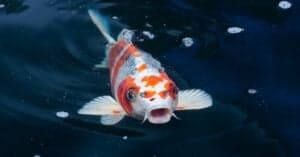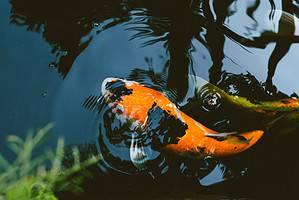Koi, which means “love” or “affection” in Japanese, have been raised in captivity for centuries for a variety of purposes. Originally raised as a source of food, koi fish eventually gained popularity as ornamental fish. They have been bred for this purpose ever since and there are many varieties available for purchase.
In this article, we’ll talk a little bit about a few of the most popular varieties of koi fish available. We’ll also talk about what foods to feed your fish and how you should maintain your koi’s environment.
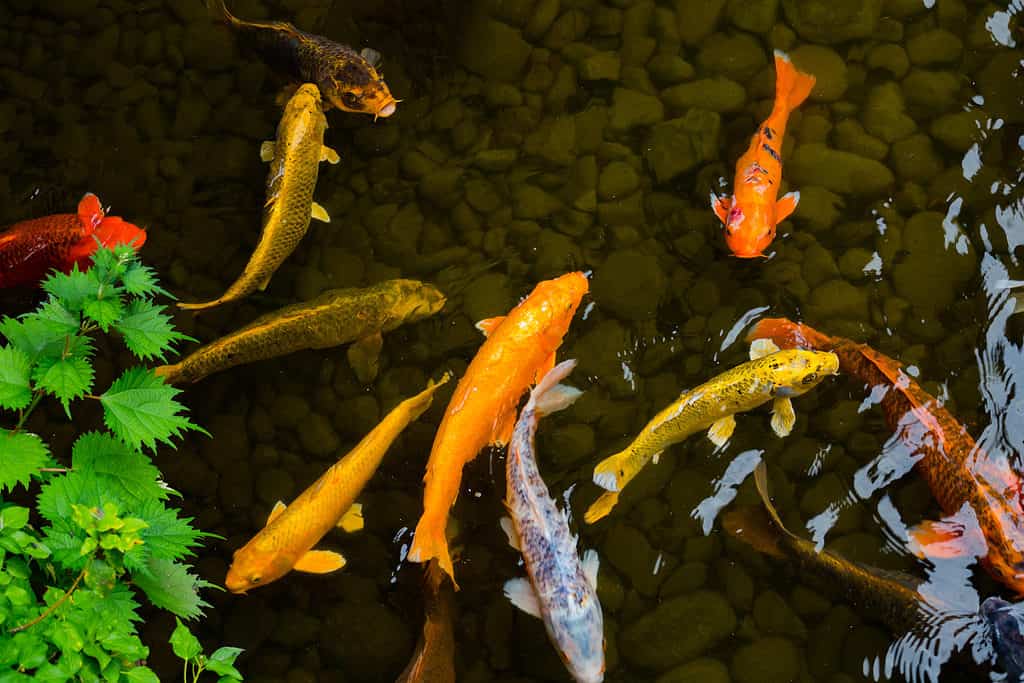
Koi fish in a garden pond.
©glory_yabe/Shutterstock.com
Types of Koi Fish
All koi fish are descendants of the wild species of amur carp, Cyprinus rubrofuscus. This species of carp is native to Laos, Vietnam, and China, and has been domesticated over many centuries. Today, there are well over 100 varieties of domesticated koi fish, but there are three that are by far the most popular. People usually refer to these three varieties collectively as “Gosanke”, which means “three families” in Japanese. These three varieties of koi, Kohaku, Sanke, and Showa koi, each have distinct markings and patterns that set them apart.
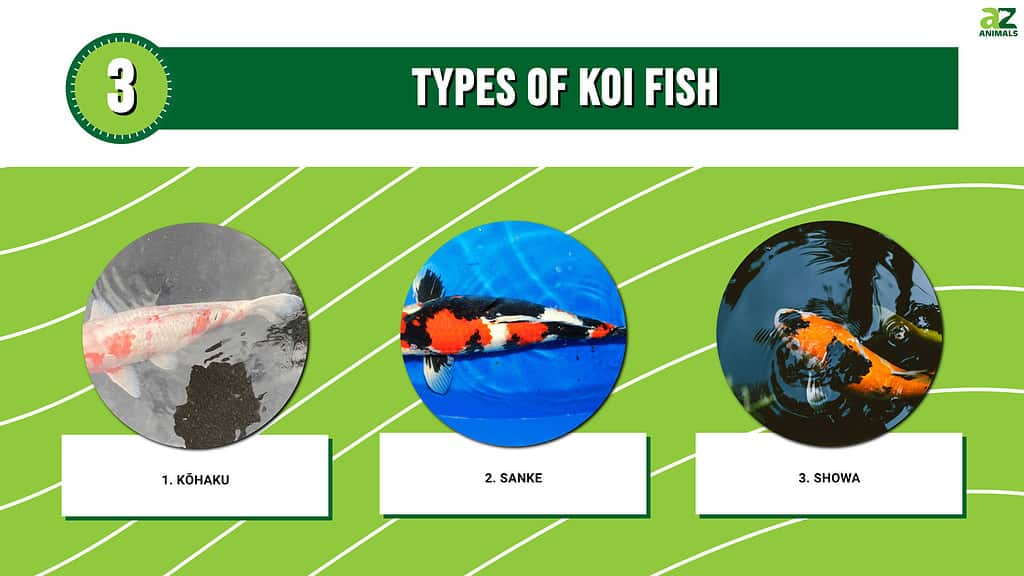
Kohaku
Kohaku koi are likely the oldest variety of koi, developed in 1888. The bodies of these koi are primarily a metallic white with red markings, called hi. When choosing kohaku koi for their aesthetic qualities, serious hobbyists and exhibitionists look for hi markings with sharp, defined edges. Additionally, the colorations should be distinct. Whether or not the koi has scales, the red markings should have no white inclusions. In order for a fish to qualify as a true Kohaku koi, it has to have red markings on its head.
Sanke
These iconic koi are popular with professional breeders, hobbyists, and casual fishkeepers. Sanke koi, also referred to as Taisho Sanke, are defined by their pure white bodies and red and black markings. The majority of their bodies is white with an overlay of beautifully contrasting red and black patterning. Young fish may have a slight blue tint to their black portions, but this may change with age. At adulthood, true Sanke koi should display no other colors.
Showa
People often confuse Showa koi for Sanke koi. Fish of this variety exhibit the same colors, white, red, and black. However, their primary body color is black rather than white. When selecting these fish for their aesthetic qualities, professional koi keepers look for the same crisp edges and inclusion-free patches of coloration as when choosing other koi.
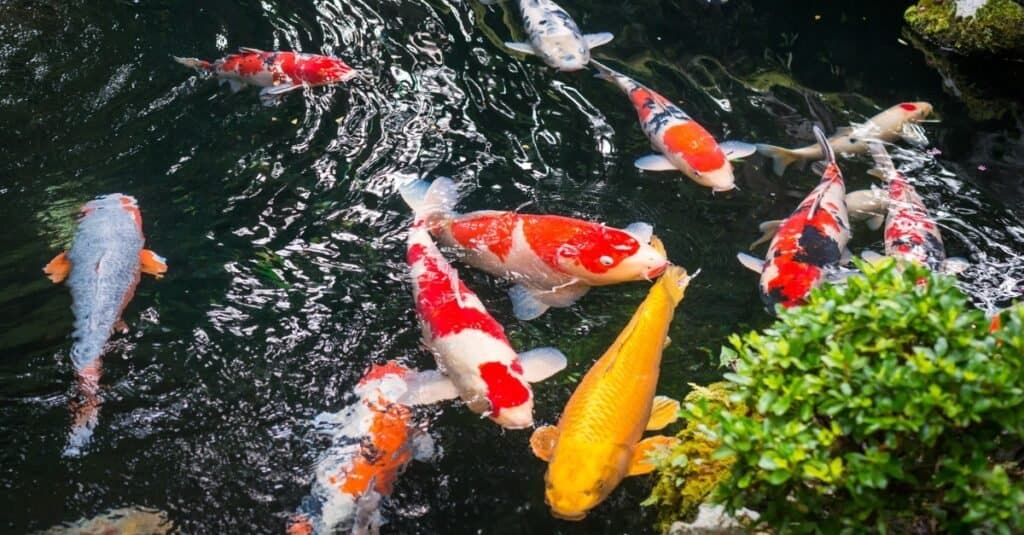
Beautiful Koi in a pond in Japan. At center, two Kohaku koi. Just to their right are multiple Sanke koi fish. Koi with a yellow coloration are called Yamabuki.
©M_MUC1968/Shutterstock.com
How to Care for Your Koi Fish
Koi fish are pretty hardy and their care is very straightforward, especially if you have any experience caring for freshwater fish. Below, we’ll talk about some of the basic things you’ll want to keep an eye on in your animal’s environment. We’ll also talk about what to feed your fish and how often to do it.
Feeding
Koi are omnivores, which means they can eat a greatly varied diet. In the wild, these carp will eat just about anything. Plants, algae, insects, and other fish are all important parts of their diet.
You can (and should) give your koi a varied diet as well! While commercial pellet foods are a good staple, your koi will enjoy and benefit from other foods. You can give them cut-up cabbage, apples, bananas, spinach, and peas. They also enjoy live foods like bloodworms, mealworms, and daphnia.
Whatever you feed them, be sure you feed them regularly. Although they can go long periods of time without eating, it isn’t good for them. You’ll want to feed them at least twice per day. However, make sure that you only feed them what they can eat in about 3 minutes. Any food that isn’t eaten can sink to the bottom or fall into gaps and cracks in your hardscaping. There, it will rot and degrade water quality.
Water Parameters
As with any fish, you should maintain your water quality to the highest possible standards. Regular monitoring of nitrate, nitrite, and ammonia is crucial. To do this, you can use commercially available water test kits.
Your fish will naturally introduce nitrogen to the water via their waste. As this waste breaks down, it releases nitrogen into the water in the form of ammonia. There are some nitrifying bacteria, like Nitrospira and Nitrosospira, that drive your tank’s nitrogen cycle, breaking this ammonia down into nitrite and then into nitrate, which is significantly less toxic. It takes time for these bacteria to build up in any cultured aquatic environment, however. We call this buildup period “cycling”. If your tank isn’t cycled properly, any fish that you introduce will become stressed and injured, and are likely to die.
Many people use live fish to introduce ammonia to the tank, but you don’t have to harm animals to get the nitrogen cycle rolling. Starting the nitrogen cycle in this way is called fishless cycling and often involves adding pure ammonia in the proper ratios for a period of days or weeks. To tell when your tank has finished cycling, you should test for ammonia, nitrite, and nitrate regularly. Once your tank has cycled, you should read 0ppm of both ammonia and nitrite, and have nitrate readings.
Water Changes
Even once your tank has finished cycling and your biological filter is doing its work, you will still need to help remove the nitrates from the water. Live plants can help use up this nitrate, but the best way to keep the nitrate level down is by doing regular water changes. The volume and frequency of your water changes will vary based on your pond’s population and water volume.
To help keep your animals’ environment as consistent as possible, you should always know the quality of anything you add to the water. Test your tap water regularly before adding it to your tank or pond. If it is different, adjust the new water to match the current tank or pond water before adding it, especially if you are performing a large water change. If you must adjust the water parameters in your animals’ environment, you should do so gradually unless there is an emergency.
pH
Koi fish prefer a pH that is near neutral (around 7), slightly alkaline, or alkaline (around 8, but up to 9) and do not do well in environments where pH regularly fluctuates. Koi are not particularly sensitive to water hardness except as it affects pH. Keep an eye out for low pH (<6.8) which may signal an impending pH crash.
Plants
Live aquatic plants are great for any pond setting. They not only give your fish natural cover but also help keep your pond’s dissolved oxygen levels up. If you have enough of them, plants will also help keep water quality high by using dissolved nitrate! Additionally, they support smaller aquatic life like snails, crustaceans, and insects that your fish can nibble on.
It may be difficult to keep plants in your pond unless the pond is particularly big or your plants are fast growers. Koi are omnivorous and some individuals will gobble up any plants they come across. Floating plants, like duckweed, water lettuce, and the like, are favorite koi snacks. Larger plants like water lilies and cattail may not be eaten. If you’d like to have plants in your pond but your fish won’t allow it, consider cordoning off a space in the pond specifically for your plants to grow.
Keep in mind that growing certain plants in your pond necessitates certain types of soil or soil-like substrates. Do research before adding these to your pond, especially if it is well-established. Certain substrates can buffer water and change its parameters over time. Additionally, you will want to quarantine any new plants for at least two weeks to help prevent any hitchhiking bacteria or parasites from entering your pond.
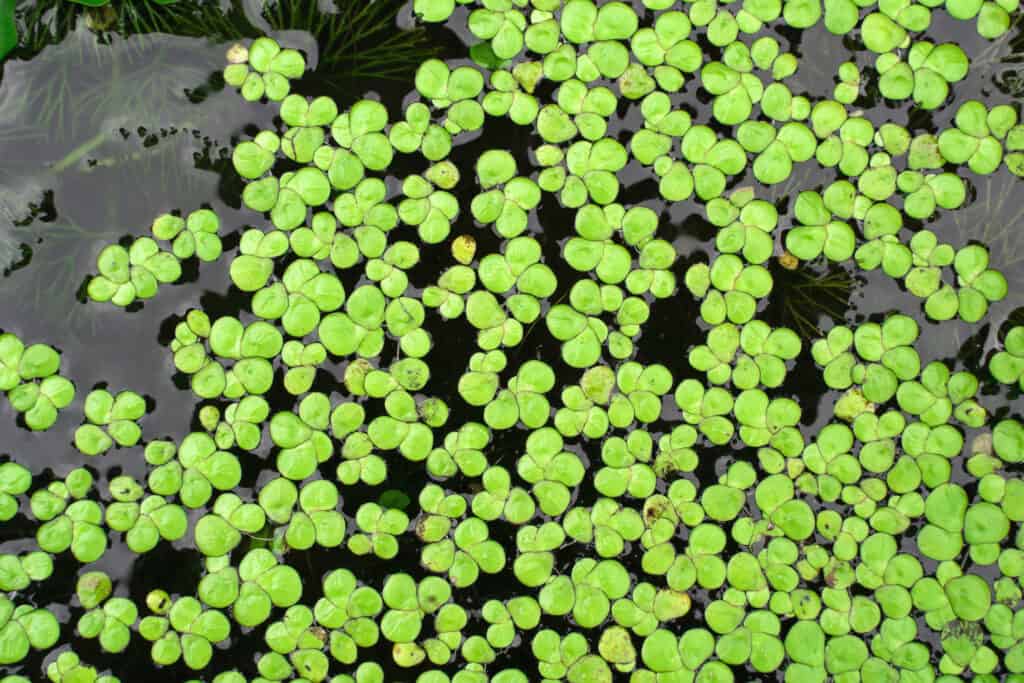
Common Duckweed. This rapidly-reproducing plant is a favorite snack for koi fish! It also provides surface cover for your pond. It can be invasive, though, so be careful when cultivating it.
©iStock.com/Piyavachara Arunotai
Can I Keep Koi Fish in a Tank?
You should not keep koi fish in an indoor aquarium for the entirety of their lives unless you can provide a very large setup. Although small koi can survive in an aquarium, they will quickly outgrow small living spaces. By the time a single koi reaches about 6 inches in length, it will already require a tank setup that is larger in footprint than a standard 55-gallon.
Keeping even a single adult koi in a small tank long-term will negatively affect its health and well-being and subject the animal to unnecessary stress. Additionally, in order to maintain its water quality, you will need to perform water changes pretty frequently — even with a filter. Although there are circumstances where tank confinement is beneficial or necessary, you should ideally limit the time your fish spends in a tank before moving it into a pond environment large enough to support it.
Tips for Breeding Koi Fish
If you’re considering breeding your koi fish, it is absolutely important to make sure that you have the time, space, and resources to do so. You will also need to have fish that are old enough to reproduce. Koi younger than 3 years of age are still technically juveniles and are not able to reproduce successfully.
Be aware that adult koi may reproduce on their own if their pond environment is sustaining them healthily. If there is enough space in the pond and enough cover to support the eggs and successive fry, your koi will likely increase their numbers without your intervention.
About Koi Breeding
Koi breeding season begins in early spring once water temperatures increase past 68 degrees Fahrenheit. By this point, your fish will have begun to awaken from their winter dormancy period. In a pond environment where there are plants, rocks, and other cover, your koi may reproduce on their own.
If your fish aren’t reproducing on their own, however, or you’re interested in trying to breed specific members of your pond, you may opt to help them along. This process is usually taxing on the fish involved and requires a fair bit of effort on your part. Additionally, you’ll need to have a specific setup of recovery and breeding tanks to encourage reproduction and allow the female to recover post-spawning.
Special Tank Setups
If you’re going to attempt to breed your fish, you will need at least one separate breeding tank and a recovery tank. Each of these tanks should be squat and wide, allowing ample space for the fish to move around. Oftentimes, breeders will use tanks that are each 4 feet square and 2 feet deep. It’s not just about the tank volume. Square footage is important in this case.
Both tanks will need adequate filtration. The breeding tank will need a substrate and either live or false plants for the koi to spawn their eggs into. These plants serve not only as an attachment point for the eggs but also as cover for the fry once they hatch. Additionally, tank foliage will encourage your fish to reproduce.
Once your fish have reproduced in the breeding tank, it is essential that you use the correct filtration method. Hang-on-back and submersible filters and pumps can pull in eggs and fry and subsequently destroy them. It is essential that you use something akin to a sponge filter to clean your tank’s water. Because this type of filter relies on the significantly gentler movement of air bubbles to draw water through the filter sponge, it will not be able to harm the fry. Additionally, because they are aerator-driven, these types of filters help to increase your water’s oxygen content.
This particular activity requires quite a bit of space to pull off in a manner that is safe for your fish and their offspring. It’s not necessarily for everyone. The best thing that you can do if you want to breed your koi is to give them an environment where they will reproduce naturally and without intervention.
Summary of 3 Types of Koi Fish
| Number | Type of Koi |
|---|---|
| 1 | Kōhaku |
| 2 | Sanke |
| 3 | Showa |
The photo featured at the top of this post is © iStock.com/coffeekai
Thank you for reading! Have some feedback for us? Contact the AZ Animals editorial team.



